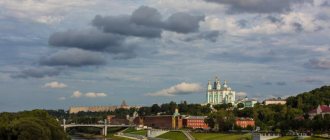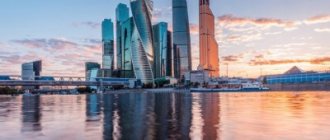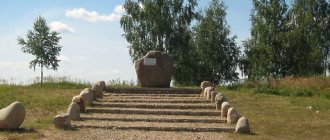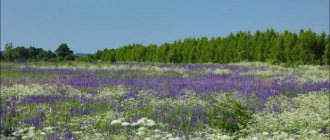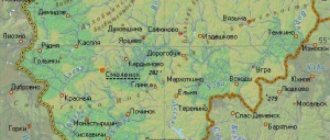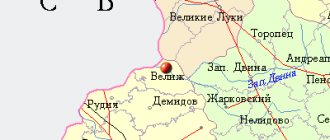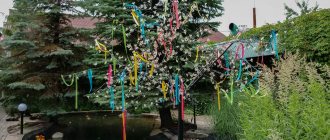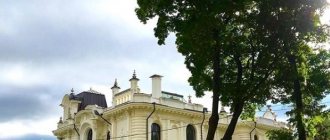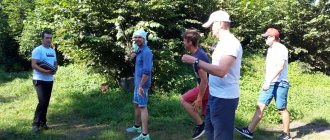The history of Smolensk begins along with the history of the Old Russian land. According to one version, the name of the city on the Dnieper comes from the Slavic designation for the black, swampy land on which the city was built - smol. Others claim that the city's inhabitants produced resin to strengthen boats. They were called Smolensk.
In 882, Prince Oleg annexed Smolensk to his lands, uniting two centers under his rule - Kyiv and Novgorod.
All events that took place in Russian and Russian history were one way or another reflected in the history of this city.
The formation of statehood, the great “zamyatnya” (civil strife), the Time of Troubles, the Napoleonic invasion and the Great Patriotic War. It is enough to walk around the city and get acquainted with its sights - history comes to life.
- Guide to the Smolensk region: what else you must visit besides Smolensk itself.
- If you are traveling to Smolensk by car from Moscow, you can stop at two interesting cities along the way - Mozhaisk and Vyazma.
Preface
For several years now I have been living in the capital, where I moved from the south, but there was no time to explore the beauty of central Russia, although I really wanted to look at old Russian churches and ancient monasteries, wander through the pine forest and pick mushrooms.
As soon as I had a couple of free days, I went to the Smolensk region, which is adjacent to the Moscow region. I chose this region based on considerations of travel distance - it’s quite close, and you can see everything you need in a weekend. Of course, there is still “the Russian spirit, it smells of Russia”: fields, forests, churches. In a word, everything was as I had planned. The Smolensk region is rich in historical events; it was from the Smolensk region that most of the military invasions of Russia by Western countries began.
Travel and planning
The trip is planned for September 16-17, that is, leave on Saturday morning, spend the night and return to Moscow by Sunday evening. I wanted to visit two small towns in the Smolensk region - Vyazma and Gagarin, visit the famous Griboyedov estate and visit friends in the village of Novoye Selo near Baskakovo, and spend the night there. The road ran through the Mozhaiskoye Highway, after which it was necessary to exit onto the Minskoye Highway and head west.
I set off on my trip in my Lada Kalina, whose fuel consumption is approximately 6-8 liters per 100 km. Since the journey only to Gagarin was about 200 km, I immediately filled up a full tank for 2000 rubles.
The road from Moscow to Gagarin along the Minsk highway
Churches and Temples
Cathedral of the Assumption of the Blessed Virgin Mary (Assumption Cathedral)
Address: Cathedral Courtyard, 5 Phone: , 38-07-57 Website: https://smol-kafedra.cerkov.ru/ Opening hours: 06:00 - 20:00 daily
The Holy Assumption Cathedral has a centuries-old history. On Cathedral Hill at the beginning of the 11th century, at the behest of Prince Vladimir Monomakh, a temple was founded “in Smolensk, the Holy Mother of God of the Episcopal Stone.”
During the Time of Troubles, the temple was damaged due to the explosion of gunpowder warehouses located nearby. Before the liberation of Smolensk from the hands of the Polish invaders, it housed the see of the Smolensk Archbishop of the Russian Uniate Church. In the 17th and 18th centuries the temple was rebuilt several times. It received its current appearance thanks to the architect P. Obukhov in 1772, who installed a five-domed structure on the temple. The golden stars of the blue domes are visible from afar - they give their radiance to the entire area.
The temple was not destroyed either during the Napoleonic invasion or during the German occupation. Historians claim that Bonaparte posted guards at the cathedral, which amazed him with its beauty and grandeur. Wehrmacht General Guderian admired the beauty of the cathedral in his memoirs.
From Cathedral Hill you can see the Trinity Monastery (they were once connected by a wooden bridge across a moat).
Trinity Monastery
Address: Bolshaya Sovetskaya, 9 Phone: Website: https://stmonastir.ru Opening hours: 06:00 - 18:00 daily
Smolensk Holy Trinity Monastery was founded at the end of the 17th century. Until 1740, it housed the residence and resting place of the Smolensk rulers.
Trinity Cathedral was erected from stone under the direction of the architect from Moscow Ivan Kalinin in 1672-1675. The stone Church of the Conception of St. Anne (Annozachatyevskaya) was built a century later. Since 1767 she became a sick leaver.
1812 - the monastery was devastated, looted and destroyed. There was no hope for its restoration, but after 8 years the Monastery was revived. During the Great Patriotic War, neither occupation nor destruction broke the monastery - life in the monastery does not subside.
Today the Holy Trinity Monastery of Smolensk is a place of pilgrimage. Here is the icon of the Iveron Mother of God (ancient and especially revered). People come here with their troubles and grief, with joy and faith.
Trench Church of Smolensk
Address: Okopnaya st., 1 Telephone:
The temple, consecrated in honor of the Savior Not Made by Hands, was erected near the city cemetery in 1776. This place was popularly called a “trench” because here in 1632 there was a land rampart around a military camp.
The peculiarity of the church is that it was built on a 12th century foundation. The temple was built in several stages and in different architectural styles. Most of the building is made in the Baroque style, and the belfry is in the Classicist style.
Believers venerate the miraculous shrine of the temple - the image of the Mother of God “Tenderness”. The temple contains a copy of the image that disappeared after the revolutionary events and was found in 1103.
Particularly revered Smolensk residents were buried near the walls of the temple. The first historian of Smolensk, priest Nikifor Murzakevich, is buried there.
Church of the Archangel Michael (Svirskaya)
Address: Parkovaya st., 2-A Telephone:
The church was erected in 1194. Its creators planned to outshine all other churches in the area. Smolensk Prince David Rostislavich tried to ensure that the church at his court was distinguished by the richness of its interior decoration and architecture unusual for that time.
People call the church Svirskaya, since merchants from the Svir lands transported their goods through the place where it was built. At the beginning of the 17th century. The Polish-Lithuanian conquerors turned the Orthodox church into a Catholic church. After liberation, the church was reconsecrated.
During the Napoleonic War, the church was plundered by French soldiers. Emperor Alexander I took a huge part in the restoration of the shrine. At the end of the 19th century. After the restoration, at the expense of the merchant V. Khlebnikov, a school for street and low-income children was opened at the temple.
After the revolution of the 20th century. the temple was looted and a warehouse was placed in it. The temple survived the Second World War. During the Soviet period, serious restoration work was carried out several times. The original paintings on the walls and vaults of the temple have partially survived to this day.
Near the temple there is a small chapel and a holy spring.
Roman Catholic Church in Smolensk
Address: st. Uritskogo, 10
The church was erected at the end of the 19th century. and is an atypical Gothic style building for Smolensk. The first church on Smolensk land appeared thanks to the mercy of Tsar Alexei Mikhailovich. He invited the captured Poles and Lithuanians to accept Moscow citizenship after the return of Smolensk to the Moscow Principality in the mid-17th century.
The king retained the possessions and privileges of the captives who submitted. Formed by former captives, the community erected a Catholic church, which was destroyed by Napoleon's soldiers in 1812. On the site of the destroyed building, first a wooden and then a stone church was built, which acquired its current appearance by the end of the 19th century.
In the Catholic cemetery near the church lie the generals of the Russian army, famous doctors, artists and lawyers of Smolensk.
Before the Second World War, the church was transferred to the NKVD archives, and then to the city archives. The organ was destroyed, crosses were removed from the spiers, and religious shrines were looted. The archive was removed from the church building in 2012.
The building is mothballed and needs restoration.
Gagarin
The first city I encountered on the way to the Smolensk region was Gagarin, named after the first Russian cosmonaut Yuri Gagarin. Previously, the city was called Gzhatsk (named after the Gzhati River), on which it stands. At the turnoff from the Minsk highway on the way to Gagarin, I saw that same Russian forest - dense and already a little yellowed. There were often signs near the road indicating that there might be wild animals here.
Minsk highway at dawn
Finally I entered the city. The first thing that caught my eye was the wooden log houses, just like peasant huts. It is surprising that in the 21st century, Russian traditional features of life are still preserved and functioning somewhere.
Road to the entrance to Gagarin
I left the car in the center near the central square; fortunately, the town is very small, so I didn’t have to look for its attractions for a long time.
Central square in Gagarin
I studied its map in advance on the city’s official website and decided where I would walk. Near the square there is the Kazan Church, which has a fairly well-kept appearance, and next to it, in the shade of trees, a small children's playground has been built.
Kazan Church near the central square
There is also a monument to Yuri Gagarin on the square, and directly opposite it is the only Cosmos cinema in the city. Symbolic. After wandering around the square, I headed towards the Gzhat River. The river looked picturesque largely thanks to the white stone Annunciation Cathedral, which was located on its bank - this is the personification of Russian traditional beauty. Looks just like the picture.
Annunciation Cathedral on the Gzhat River
After taking photos, I crossed the bridge and headed towards the First Flight Museum. Moving away from the square, I began to notice old paving slabs, probably from the times of the Soviet Union. At the same time, the building of the museum itself was restored and well maintained. I booked an excursion costing 150 rubles.
Behind the trees, a view of the First Flight Museum building
First, I was taken into the cabin of the space rocket, then I, together with the guide, went up to the second floor, where Gagarin’s personal belongings were exhibited: the technical instruments he used, a spacesuit, books, etc. Frankly, by the end I was even a little bored. I think this museum will be of interest to people who are really involved with astronautics, because there are many items directly related to technology, which I am not very well versed in.
After the excursion, I realized that I was hungry - I needed to find a good canteen or cafe. On the Internet I found information about the Korchma restaurant. According to visitors' reviews, this is a great place to have a delicious meal and an interesting evening. The restaurant is located on the outskirts of the city, so I went there by car.
In “Korchma” the interior is stylized in Ukrainian traditions, the waitresses are dressed in something like a national costume: a loose blouse with lacing on the chest and a long floor-length skirt. The menu is also replete with traditional dishes: borscht, dumplings, solyanka. But I’m used to Western European cuisine, so I ordered the “Sea” salad with shrimp, mussels, tomatoes and sauce, as well as a glass of tomato juice. The salad was brought on a large plate, the portion was simply huge, so I was left full. This lunch cost me quite a lot - about 400 rubles.
Evening streets of Gagarin
It was getting close to evening, so I went to the village of Novoye Selo for the night. Novoe Selo is something like a modern-type farmstead, like German villages: new houses in the European style, located in a closed area where outsiders are not allowed. At the entrance to Novoe Selo there is a security post with automatic gates.
Novoe Selo
There is only one street in the village, but with perfectly trimmed green lawns and clean sidewalks.
Novoe Selo
In the middle of such an area as the Smolensk region, it is surprising to see such a settlement, where everything is brand new. My friends met me at the entrance, so I got to Novoye Selo without any hindrance, had dinner there, spent the night and had breakfast. And the next day I went to Vyazma.
Houses in Novo Selo
Tourist map of the Smolensk region
Map from the atlas of the Smolensk region in 1964. The tourist map gives an idea of the variety of natural and historical sites that local historians can get acquainted with. Hiking routes combine the most interesting ancient monuments, battlefields of the Patriotic Wars of 1812 and 1941 - 1945. with picturesque corners of nature in the middle zone of the Russian Plain. Legend
Tourist routes in the Smolensk region
Attractions on the map of the Smolensk region
Alexandrino is an ancient park with lakes and exotic vegetation (trees and shrubs).
Aleksino is a manor architectural ensemble (palace, church and other buildings) of the late 18th and early 19th centuries. Major peasant unrest in 1775
Androsovo (Andrusovo) - in 1667. The Truce of Andrusovo was signed with Poland.
Lake Baklanovskoye - to the north-east. from the lake there are limestone boulders. A picturesque place with open landscapes.
Baltutino 2nd - the site of a successful raid by partisans of the regiment named after. S. Tsazo March 5, 1942 against a group of fascist German troops.
Batishchevo - the outstanding Russian agricultural chemist and publicist A.N. lived and worked here. Engelhardt (1832-1893).
Boldino - ruins of the Boldino Monastery (1514).
Bol. Dobraya - the site of battles between the Russian army and the French during the Patriotic War of 1812.
Bolonovets is the birthplace of the partisans of the Great Patriotic War of 1941-1945. Olga Rzhevskaya.
Bohota is a mass grave of victims of the execution of the local population by the Nazi invaders in 1942.
Vazuza River - below the city of Sychevka in the river valley there are outcrops of limestone of the Carboniferous period.
Vasilyevo is a place associated with the name of the Decembrist P.I. Pestel. Here was his estate, which he visited several times during the preparation of the uprising.
Vasilyevskoye - palace, church and other buildings of the Povalishins estate 1710-1796.
Vyazma - a monument commemorating the victory of Russian troops over the French in the battle of Vyazma on August 15-17 and October 22, 1812. Monument to the Pernovsky regiment - a participant in the battle for Vyazma in 1812. Monument (sculptural group) to the commander of the 33rd Army M.G. Efremov - hero of the Great Patriotic War of 1941-1945. Trinity Cathedral and church of the 17th century.
Gzhatsk is a fraternal cemetery for communists who died in 1918 in the fight against counter-revolutionary gangs. Homeland of F.F. Solntsev - one of the 26 Baku commissars. Places associated with the life of the world's first Soviet cosmonaut Yu. A. Gagarin.
Glotovka is the birthplace of the poet M. V. Isakovsky (born in 1900).
The settlement is an outcrop of limestone from the Carboniferous period.
Demidov - an active participant in the formation of Soviet power in the city of Ya.E. lived and worked here. Demidov (died in 1918).
Desna river - in a picturesque valley on the river. Desna below s. Ekimovichi - outcrops of marine rocks (chalk and phosphorites).
Dorogobuzh - the site of fierce battles between Russian troops and the French in 1812. A monument in honor of the defeat of French troops near Dorogobuzh in October 1812. Mass grave of Soviet soldiers and partisans who died in battles with the Nazi invaders during the Great Patriotic War of 1941-1945 . The headquarters of the partisan division “Grandfather” was located here during the war of 1941-1945.
Dukhovshchina is the birthplace of the scientist-traveler P.K. Kozlova (1863-1935).
Yelnya is the site of fierce battles of the Soviet army against the Nazi invaders in July-September 1941, which ended with the liberation of Yelnya in early September 1941. This was one of the first defeats of Hitler’s troops during the Second World War. Places of active partisan actions during the Great Patriotic War of 1941-1945.
Zhukovo is the birthplace of the Decembrist I.D. Yakushkina (1793-1857).
Izdeshkovo - Carboniferous limestones with a fauna of fossils are common here.
Inkono is a granite obelisk in honor of the victory of the Russian Cossacks under the command of Platov over the French in July 1812.
Karakovichi is the birthplace of the sculptor S.T. Konenkova (born in 1874).
Kimborovo is the birthplace of the great traveler and explorer of Central Asia N.M. Przhevalsky (1839-1888).
Klushino is the birthplace of the world's first Soviet cosmonaut Yu.A. Gagarin (born in 1934).
Kolychevo - the talented Russian biologist A.A. lived and worked. Kaverznev (second half of the 18th - beginning of the 19th centuries).
Krasnoye is a granite obelisk in honor of the victory of Russian troops in the Patriotic War of 1812 and a monument on the grave of participants in the battle for Krasnoye.
Krasny Bor is a picturesque place with a pine forest.
Krivoles is a large hilly relief of glacial origin with a pine forest.
Lyubanichi is the site of a major peasant uprising in the mid-17th century. against the landowners.
Maksimkovo is the birthplace of a major artist of the second half of the 19th century. M.O. Mikeshin (1836 - 1896) - author of the monument “Millennium of Russia” in Novgorod.
Maslovo is 1 km away. from Maslov in the village of Gorodok the famous naval commander P.S. was born. Nakhimov (1802-1855).
Mikulino is a monument to six heroes - miners who died in battle with the Nazi invaders in May 1943.
Milyukovo is the birthplace of the founder of Russian soil science V.V. Dokuchaev (1846-1903).
Molevo - mass graves of soldiers and officers of the Russian army who died in a fierce battle with the French on July 27, 1812.
Molno is the birthplace and place of death of the organizer of Soviet power in Velsky district I.T. Trofimova.
Monastyrshchina is a mass grave of victims of the mass execution of the local population by the Nazi invaders in 1942.
Mochary is a group of terminal moraine ridges, an interglacial peat bog.
Novinskoye is the birthplace of the famous revolutionary worker P.A. Alekseeva (1849-1891).
Novospasskoye is the birthplace of the composer M.I. Glinka (1804-1857).
Everyday is the birthplace of the revolutionary worker P.A. Moiseenko (1852-1923) - member of the Northern Union of Russian Workers, leader of the famous Morozov strike.
Panskoye - near the village (in the village of Zagorye) in 1910 the Soviet poet A.T. was born. Tvardovsky.
Ponyatovka - the site of active partisan action in October 1942.
Prigory is the site of the successful operation of the Vorgov partisan brigade on November 5, 1942. which defeated a large garrison of Nazi troops.
Raevka - the site of battles between the Russian army and the troops of the Swedish king Charles XII during the Northern War in August 1708.
Roslavl - in November 1905, a strike of railway workers took place in the city.
Samuylovo is the center of a major peasant uprising against the predatory reform in May 1861.
Lake Sapsho is the most beautiful lake in the Smolensk region.
Sloboda - N.M. lived here for a long time. Przhevalsky (80s of the XIX century).
Smolensk - monuments to the defenders of Smolensk - heroes of the Patriotic War of 1812 and the Great Patriotic War of 1941-1945. In 1900-1903 the city was a distribution point for Lenin's newspaper Iskra. Here 1903-1905. There were two underground printing houses and a transport and technical bureau of the Central Committee of the RSDLP. Architectural monuments of the city. Peter and Paul Church 1146, Church of St. John the Evangelist 1173, Svirskaya Church 1197, fortress wall 1596-1602, Assumption Cathedral 1740, etc.
Solovyevo is the site of fierce battles during the Patriotic War of 1812 and the Great Patriotic War of 1941-1945.
Oldies are the birthplace of P.G. Kakhovsky (1797-1826) - one of the five Decembrists executed in the Peter and Paul Fortress.
Talashkino is the former estate of Tenisheva. A wooden building with carved decorations based on Russian folk epics and fairy tales (made in 1901 by the artist S.V. Malyutin). Spasskaya Church-tomb with mosaics by artist N.K. Roerich.
Tatarsk is a mass grave of victims of fascism in 1942.
Khmelita - relatives of A.S. lived here. Griboedova. In his youth, the writer himself visited.
Tsarevo-Zaimishche - obelisk in honor of the adoption of M.I. Kutuzov command of the Russian army in August 1812.
Cherepovo is the center of a major uprising of peasants from several volosts in the summer of 1862 against the landowners.
Shilovychi is the birthplace of the outstanding zoologist N.M. Kulagin (1860-1940).
Yakovlevo is a mass grave of partisans who died heroically in battles with the Nazis in 1941-1945.
Yartsevo is the site of the largest strike in the history of the labor movement of 2,500 weavers in 1880, as well as strikes in 1905, 1906, 1911, 1913 and 1916.
Note. Signs of archaeological sites (sites, settlements, burial mounds) and museums on the map are given without explanation in the text.
Vyazma
If Gagarin could still be called a certain periphery of the Moscow region, then Vyazma is the very center of the Smolensk region and the second largest city after Smolensk itself. There are two centers in Vyazma: one is a large alley-park along which the Trinity Cathedral, as well as shopping centers and shops are located; the second is a city park with a memorial, which overlooks the large automobile ring and Sovetskaya Square, where the church is located on the other side of the road.
Soviet square
I left the car and went to explore the surroundings of Vyazma on foot. The structure of the city is confusing. If Gagarin is all flat and clearly divided into squares of blocks and straight streets, then in Vyazma there are many alleys and dead ends. It will be difficult for a beginner to figure it out even from a map.
Sidewalks in Vyazma
The first thing I noticed were the sidewalks. There were practically none of them, that is, it was difficult to find asphalt, mostly there were paths sprinkled with sand.
Streets in Vyazma
There were a lot of grocery stores around, and almost none where you could buy clothes or shoes, if you exclude the market.
Supermarkets and shops on the streets of Vyazma
After walking about three blocks, I finally reached the “first” center and the Trinity Cathedral. Car traffic here is extremely busy. It is noteworthy that in this city, even on wide streets, there is often one-way traffic, which can confuse a non-local driver.
Streets and roads in Vyazma
I also regretfully noticed the poor quality of the roads and the very narrow, obviously budget speed bumps, which can be driven over at a speed of 2-5 km/h without damaging the car. In general, the quality of roads in Vyazma leaves much to be desired, both pedestrian and automobile.
A few new buildings in Vyazma
Having crossed the road, I found myself on the main alley of the city. There were flower beds, trees, benches and even a fountain, but it was clear that this square had not been looked after for a long time: benches were broken in some places, tiles underfoot were still from Soviet times, the fountains were not even plastered. After walking some distance, I turned towards the city park and Efremov Square, where the eternal flame memorial was located.
Efremov Square
Church
This park was in much better condition: the bushes were trimmed, lanterns, new benches, beautiful paving slabs. But as I delved deeper, I began to notice the former devastation. The amusement park doesn't even have night lighting, and there are no visitors or workers. The carousels are old and rusty in some places, it even became creepy. But the beautiful autumn landscapes, trees with yellow leaves and a slightly cloudy sky distracted me.
"New" park
Exit from the park to Sovetskaya Square. And a cat.
While I was walking, I felt that I was hungry. There is a pizzeria not far from the park. Having studied the reviews about it on my smartphone, I decided to have lunch there and ordered pizza to take away. Frankly, the quality left much to be desired, since the dough was thick and was not prepared in front of me, but the price was also reasonable - only 350 rubles per 800 grams.
Stella
Church
After lunch, I decided to take a random walk deep into the city, crossed the bridge over the small Vyazma River, and unexpectedly found myself in some remote area.
Vyazma River
Road from the center of Vyazma
After walking about 300 meters, I just ran into a field. Surprisingly, 15 minutes walk from the center, and now you are standing in a field among dilapidated huts. It felt like an abandoned amusement park, so I hurried to turn back.
Houses near the center
Field 15 minutes walk from the center
View from the bridge to the Vyazma River
There was still time left, so I decided to stop by the village of Khmelita, to the Griboyedov estate. The estate itself is home to the house itself - a real palace, restored and stylized in accordance with the spirit of the 19th century. This was the Griboyedov Museum, and there was also the Nakhimov Museum. However, I was already too tired to visit the museum attractions, so I simply looked around the estate from the outside, walked along the shady autumn alleys and set off on the way back.
Historical sites and museums
Stone Smolensk Fortress
The Smolensk Kremlin (a more correct definition is a fortress wall) was built at the turn of the 16th and 17th centuries. Architect Fyodor Kon was able to solve a difficult problem - to build a defensive structure and create a wonderful example of stone architecture.
The built fortress was distinguished by a three-tier battle system:
- For plantar combat - rectangular stoves with cannons
- For the middle battle there are vaulted chambers in the center of the wall
- For the top one - blind and combat teeth on the upper platform
Another feature of the fortress was and is its towers: no two of them were alike, each was built taking into account its purpose and relief. Of the 39 towers, 18 have survived today.
Several fragments of the 6.5 km fortress wall have survived. Most of it was destroyed in 1812 by Napoleon's soldiers.
Veselukha Tower
On a high hill, the Veselukha Tower looks into the distance.
Legend has it that the builders (a crack in the wall of the tower appeared again and again), at the instigation of the sorceress, sacrificed the most cheerful and beautiful girl in the city. When the girl was walled up in the wall, the crack disappeared. The restless spirit of the girl appears as a ghost and either cheerful laughter or ominous laughter is heard.
Not only the legend is impressive, but also the view from this tower: hills in the greenery of trees, the Dnieper, the domes of churches.
Eagle Tower
The most monumental of the surviving ones is the Eagle (Gorodetskaya) tower. It was destroyed twice during sieges and wars in the 17th century and rebuilt.
In the mid-18th century, counterfeiter Count Zmeyavsky organized “performances” of evil spirits on the walls of the tower to cover up his illegal activities. At that time, there were bad rumors about the tower, and the inhabitants of these places were afraid.
The gang was defeated, the underground passages were filled up.
Thunder Tower
Address: October Revolution Street, 3 Website: https://www.krepost-smolensk.ru Opening hours: 10:00 – 18:00 Tuesday - Friday Cost: 80 rubles
This is the only tower that you can get into. It houses the Smolensk - Shield of Russia museum, dedicated to the military history of the city. On the third tier there is a functioning observation deck.
Nikolsky Gate of Smolensk
Address: Gagarina Avenue, 19-a Working hours: from 10.00 to 18.00 weekends - Sat, Sun Telephone:
Smolensk fortress walls began to be built around Smolensk under Tsar Fyodor Ioannovich. One of the first Russian architects, Fyodor Kon, built walls 6 m thick. Each tower had its own purpose. Nikolskaya served as a passage to the fortress. It was through it that Emperor Napoleon entered Smolensk.
Initially, the tower was called Elenevskaya - after the village of Yelnya. It could be reached by the road leading out of the fortress. The name Nikolskie was assigned to the tower in the 18th century, when the Church of St. Nicholas was erected nearby. During this period, the gate was crowned with an icon depicting a saint.
Currently, a busy city highway passes through the Nikolsky Gate. A through passage appeared in the wall in 1902, when a tram was launched in the city. The real gate is now protected by bars and represents a corridor through the Nikolskaya Tower. The tower today houses the collection of the Flax Museum.
A wooden staircase leads to the top of the tower. The passage there is closed.
Museum "Smolensk - Shield of Russia"
Address: st. October Revolution, 3, bldg. 1 Opening hours: 11.00-19.00 Tue-Sun, closed on Mon Ticket price: from 100 rubles Telephone:
The Museum of Military History of the Russian Military Historical Society “Thunder Tower” (the name was assigned in 2022) is located in one of the 22 fortress towers of Smolensk that have survived to this day. The Thunder Tower was built in the 17th century. You can get to the top via an internal steep staircase. From the lookout platform on the 4th floor there is a panoramic view of Smolensk. An observation deck is also located on the 3rd floor in the hall where military equipment and clothing of 13th century warriors are displayed.
The exhibition on the 1-2 floors of the museum tells about the construction of the fortress wall around the city. Materials are demonstrated about the defense of Smolensk during the 20-month siege of the fortress in the Time of Troubles. The museum contains a large collection of historical objects from the 16th and 17th centuries: building materials and tools, military armor. Visitors will learn about the history of wars and peace treaties of Smolensk in the 17th century.
The museum exhibits a model of the Smolensk fortress, made from an engraving by the artist Hondius. The model fully corresponds to the surviving drawings of the 17th century.
Historical Museum of Smolensk
Address: st. Lenina, 8 Opening hours: 10.00-18.00 Tue-Sun, closed - Fri Ticket price: from 150 rubles Telephone:
The museum was opened at the end of the 19th century. The museum exhibits tell about the history of the Smolensk land. A collection of archaeological finds from ancient history (up to the 9th century) has been collected: stone axes, household utensils, jewelry. A mammoth skeleton found in the Smolensk region is on display.
The exhibition dedicated to the history of the Smolensk region as part of the Old Russian state contains Byzantine imperial coins, the seal of Prince Vyacheslav Yaroslavich, weapons, birch bark letters, etc. (period 9-13 centuries). Many exhibits were found during archaeological excavations in the Gnezdovo burial mounds. For example, the museum displays a fragment of a Slavic house, which is 8 centuries old. All exhibits are accompanied by reference and documentary materials.
A large section of the museum exhibition contains information about the history and culture of the Smolensk land in the 13th-19th centuries. The rich collection of numismatics arouses the interest of visitors. The museum reflects the most significant historical events that unfolded in the Smolensk region.
Art Gallery
Address: Kommunisticheskaya st., 4 Opening hours: 10.00-18.00 Wed-Sun, 11.00-19.00 Thu, 10.00-17.00 Fri, closed - Mon Ticket price: from 150 rubles Telephone:
You can take an audio-guided tour of the gallery. It is possible to download the excursion to your phone using a QR code.
The gallery opened in 1920. A collection of ancient Russian icons from the 15th to 19th centuries is exhibited here. The works of Russian artists are demonstrated: I.K. Aivazovsky, V.A. Serov, I.E. Repin, K.A. Korovin, etc. An extensive collection of paintings and sculptures by artists of the 20th century is presented. Collected works by great Western European masters: Bernardo Strozzi, Giovanni Pellegrini, etc.
Museum "In the World of Fairy Tales"
Address: Lenina st., 15 Opening hours: 10.00-18.00, Fri 10.00-17.00 Ticket price: from 80 rubles Telephone:
The museum has been operating since 1992. The creators of the museum took into account the characteristics of children's temperament and developmental psychology. Young visitors are allowed to touch all the characters: Baba Yaga, Snake Gorynych, Vodyany, the princes and princesses. You can also try on the clothes of your favorite fairy-tale character.
The museum is focused on studying folk tales and the works of domestic children's writers and animators. The animators do their best to entertain the children. In addition to the exhibits, which are works of art by famous masters, the museum exhibits works by children.
Museum "Smolensk Flax"
Address: Nikolskaya Tower of the Smolensk Fortress Wall, st. Marshala Zhukova Telephone: Opening hours: 10.00-18.00, Fri 10.00-17.00, closed on Monday Ticket price: from 80 rubles
The museum tells in detail about the cultivation of flax, the production and use of flax.
The museum exhibits a large collection of linen clothing from different eras and representatives of different classes, examples of Russian creativity and linen textiles. Museum visitors will be able to take lessons from linen craftsmen and learn how to work on ancient weaving looms.
City Smithy
Address: Lenina st., 10A Telephone: Opening hours: 10.00-17.00, Wed 10.00-16.00, closed - Thu, Mon Ticket price: 80 rubles
In the oldest civil building in Smolensk from the 17th century. there is an exposition of the city blacksmith shop. Since 1982, the forge museum has recreated the atmosphere in which the master works. Among the exhibits: a blacksmith's forge with bellows, an anvil, and blacksmith's working tools.
Adding to the realism is a guide dressed as a blacksmith, who introduces visitors to authentic tools and blacksmith products of the 17th-19th centuries.
Results
I can’t say that traveling through the cities of the Smolensk region left me with many impressions, but anyone who wants to see the life of a real Russian outback, where wooden huts, birch groves and Russian nature still remain, should definitely visit this area.
In terms of entertainment, it's boring here. For example, in Vyazma there are not even cinemas. At the same time, the trip was inexpensive, the main costs were precisely on the road: 200 km from Moscow to Gagarin, 20 km from Gagarin to Baskakovo, 60 km from Baskakovo to Vyazma, 36 km from Vyazma to Khmelita, 240 km from Khmelita to Moscow - that was approximate route. On average, the mileage was 560 km, so we had to refuel several times. In general, 5 thousand is enough for tickets to museums, travel and food.
Author: Ekaterina Sineok
